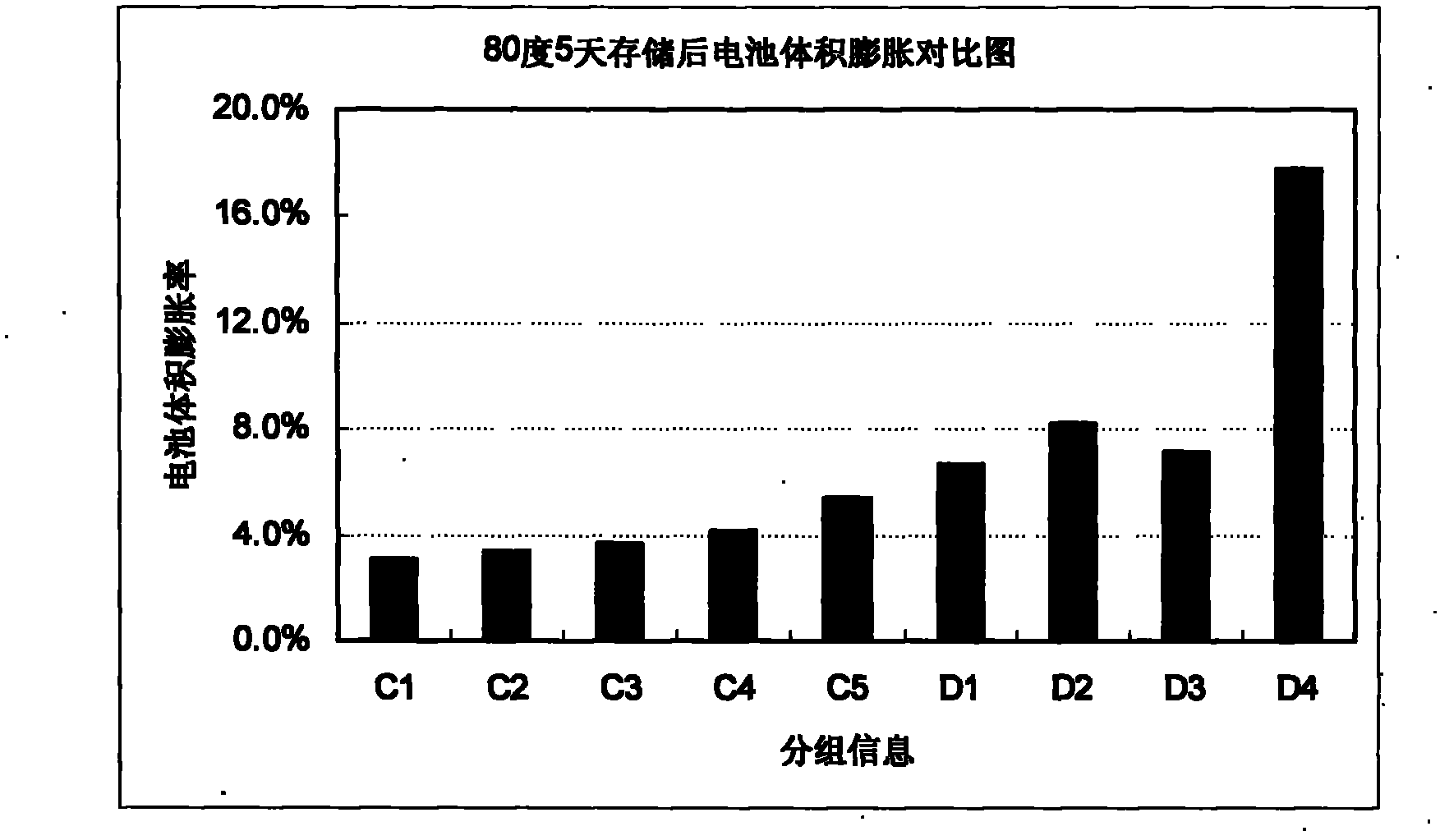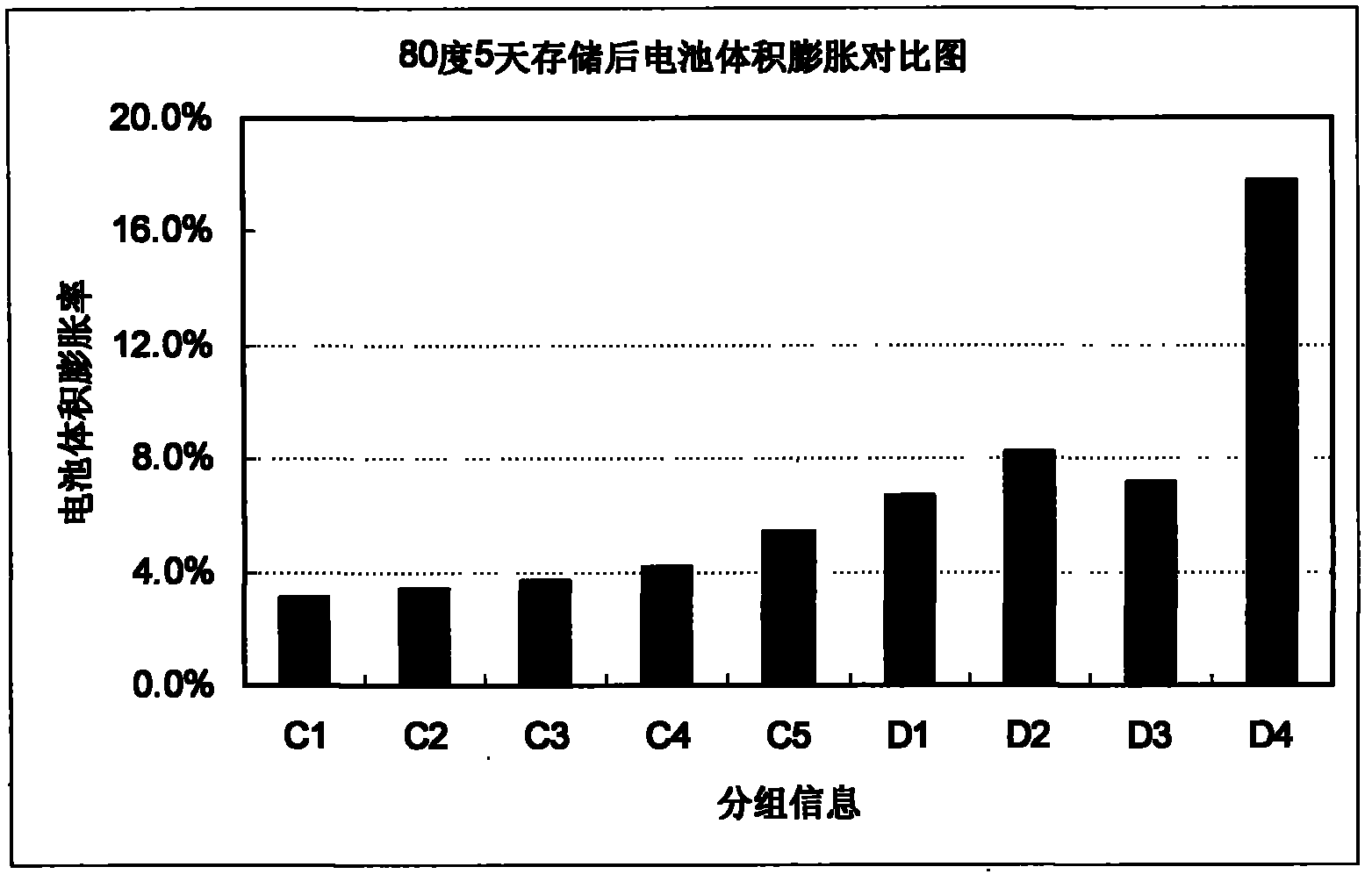A kind of non-aqueous electrolyte battery
A non-aqueous electrolyte and battery technology, applied in secondary batteries, circuits, electrical components, etc., can solve the problems of reducing battery power performance, increasing battery internal resistance, and failing to improve the activity of active materials, so as to improve high temperature performance, effect of suppressing swelling phenomenon
- Summary
- Abstract
- Description
- Claims
- Application Information
AI Technical Summary
Problems solved by technology
Method used
Image
Examples
Embodiment 1
[0022] Preparation of positive electrode
[0023] Lithium cobalt oxide (LiCoO 2 ) as the positive electrode active material, PVDF (polyvinylidene fluoride) is used as the binder, and conductive carbon black is used as the conductive agent. piece.
[0024] Preparation of negative electrode
[0025] High-energy-density graphite is used as the negative electrode active material, SBR (polystyrene, butadiene suspension) is used as the binder, CMC (sodium carboxymethylcellulose) is used as the thickener, and conductive carbon black is used as the conductive agent. After the prepared slurry is coated on both sides of the negative electrode current collector composed of copper foil, it is dried and pressed as the negative electrode sheet.
[0026] Preparation of separator
[0027] The isolation film can be made of PE, PP and PP / PE / PP three-layer materials. In order to improve the high temperature stability of the isolation film, a layer of oxide ceramic layer is usually coated on ...
Embodiment 2
[0033]The positive electrode, negative electrode, and separator used in Example 2 are the same as in Example 1. For the specific preparation process, please refer to the preparation of the positive electrode, the negative electrode, and the separator in Example 1.
[0034] Electrolyte preparation
[0035] Mix ethylene carbonate (EC), propylene carbonate (PC), ethyl methyl carbonate (EMC) and diethyl carbonate (DEC) in a volume ratio of EC:PC:EMC:DEC=1:3:5:1 ; Then add BP of 1wt% and VC of 1wt% and ADV of 0.5wt% in the mixed solvent; With LiFP 6 is the electrolyte salt, the concentration is 1mol / L, and the electrolyte S2 is prepared.
[0036] Preparation of non-aqueous electrolyte battery
[0037] The positive pole piece, negative pole piece and separator obtained in the above preparation process are wound into bare cells, and the outer packaging of the battery is made of aluminum-plastic composite film. The electrolytic solution S2 is made into a soft-package lithium-ion ba...
Embodiment 3 to 5
[0039] The positive electrode, negative electrode, and separator used in Examples 3 to 5 are the same as in Example 1. For the specific preparation process, please refer to the preparation of the positive electrode, the negative electrode, and the separator in Example 1.
[0040] Electrolyte preparation
[0041] Take ethylene carbonate (EC), propylene carbonate (PC), ethyl methyl carbonate (EMC), diethyl carbonate (DEC) and mix, the volume ratio is shown in the table below; with LiFP 6 is the electrolyte salt, the concentration is 1mol / L, and the electrolytes S3, S4, and S5 are prepared respectively.
[0042] The electrolyte solvent ratio that table 1 makes to embodiment 3 to 5
[0043] Example
Electrolyte number
Solvent ratio (mass ratio) used in electrolyte preparation
Example 3
S3
EC:PC:EMC:DEC=1:3:1:5+0.1%BP+3%VC+0.5%ADV
Example 4
S4
EC:PC:EMC:DEC=1:2:7:0+2%BP+1%VC+1%VA
Example 5
S5
EC:PC:EMC:DEC=3:2:2:3+...
PUM
 Login to View More
Login to View More Abstract
Description
Claims
Application Information
 Login to View More
Login to View More - R&D
- Intellectual Property
- Life Sciences
- Materials
- Tech Scout
- Unparalleled Data Quality
- Higher Quality Content
- 60% Fewer Hallucinations
Browse by: Latest US Patents, China's latest patents, Technical Efficacy Thesaurus, Application Domain, Technology Topic, Popular Technical Reports.
© 2025 PatSnap. All rights reserved.Legal|Privacy policy|Modern Slavery Act Transparency Statement|Sitemap|About US| Contact US: help@patsnap.com



